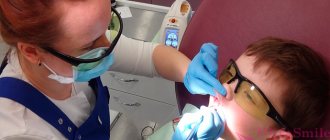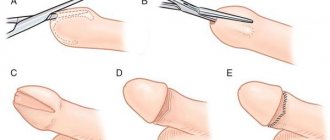Reasons for the development of pathology
In the vast majority of cases, a short frenulum is a consequence of a developmental abnormality and is combined with phimosis - a narrowing of the foreskin with the impossibility of exposing the head of the penis. According to statistics, up to 5% of uncircumcised men suffer from insufficient extensibility of the folds of skin on the penis. This anomaly is accompanied by a number of painful and unpleasant symptoms:
- curvature of the penis in an erect state;
- pain during sexual intercourse;
- premature ejaculation;
- the frenulum breaks as a result of active movements during intercourse.
With normal development, the frenulum is of sufficient length and can stretch significantly, providing comfortable and painless movement of the foreskin. A fold of skin that is too short causes a lot of trouble and can cause serious complications.
Short frenulum: to treat or not to treat?
Hello dear audience, today I, urologist-andrologist Gennady Valentinovich Volovich, would like to consider such a problem as a short frenulum.
Many male representatives believe that this is not a problem at all, many do not notice it in themselves, many believe that it does not need to be treated.
However, relying on my experience and the opinion of my colleagues, I must tell you that a short frenulum can cause many problems
What is a short bridle?
A short frenulum of the penis is a congenital anomaly, manifested in insufficient length of the skin cord between the foreskin and the head of the penis.
Normally, the head of the penis deviates downward relative to the main axis of the shaft of the penis from 0 to 30 degrees. Over 30 degrees is already excessive, and readings of 25-30 degrees can also cause problems under certain circumstances. That is, from 20 to 30 degrees is a relative norm.
Most often, this pathology is detected during the first sexual intercourse, since during an erection the shortened frenulum is subject to excessive tension and rupture. In this case, the injury may be accompanied by severe pain and profuse bleeding, which can lead to significant blood loss, since a large artery passes through the thickness of the frenulum. In less severe forms of this disease, a man may experience:
- strong tension of the frenulum in the erect state of the penis and the development of pain (including during sexual intercourse);
- insufficient filling of the cavities of the cavernous bodies with blood and, as a result, insufficient increase in the volume of the penis and its hardening;
- strong curvature of the penis towards the scrotum, making sexual intercourse very difficult (or even completely inaccessible);
- development of sexual dysfunction, in which ejaculation occurs too quickly; damage to the frenulum during sexual intercourse in the form of cracks and tears with bleeding, which can be very profuse. Bleeding occurs at the most inopportune moment and you have to urgently look for a hospital with improvised bandages
- Due to the incorrect excessive bending of the head of the penis downwards during sexual intercourse, the partner may experience excessive friction in the area of the lower wall of the vagina, vaginal dysbacteriosis occurs, the girl-woman undergoes expensive smears, is treated, but all in vain, since the field of sexual intercourse arises again dysbiosis.
If left untreated, due to frequent tears, the frenulum can turn into a painful scar cord. This entails increased sensitivity of the glans penis, which, in turn, can provoke premature ejaculation. And as a consequence of this, one’s own dissatisfaction and that of one’s partner.
And here's the result:
The development of complications can only be prevented by surgery, and the earlier treatment is started, the fewer old tears in the frenulum, the easier this problem is to correct and the better the postoperative result. The only way to treat this pathology is plastic surgery to lengthen the frenulum - frenuloplasty. It is performed on an outpatient basis under local anesthesia and lasts about twenty minutes. The essence of this surgical intervention is to dissect the short frenulum of the penis in the transverse direction. In some cases, up to three incisions may be required.
The patient can return home on the same day. Wound healing continues for 8-14 days.
In our center, any version of frenuloplasty is performed: using a scalpel, radio knife or laser.
Take care of your health and the health of your partner, check with a urologist for the presence of this pathology, and if there is a problem, have a frenuloplasty.
Possible triggers
Other possible causes of pathology are:
- Chronic inflammatory diseases of the penis
. Balanitis and balanoposthitis, in most cases occurring with the presence of pathogenic microflora, lead to structural tissue changes in the area of the head of the penis. - Chronic injuries to the foreskin
. Even microdamages to the delicate skin of the penis without proper and timely response can lead to improper tissue fusion. Such injuries occur when playing certain sports or wearing too tight underwear and clothes. - Diabetes mellitus in the stage of decompensation
. In this case, tissue changes are caused by a characteristic sign of the disease - a disruption of the regeneration process, as a result of which cicatricial deformities begin to appear in the tissues of the frenulum.
Most often, the pathology is diagnosed when a man begins to have an active sexual life. That's when the real problems begin. Especially if the disease is not detected and treated in time.
Causes of pathology in children
It is not possible to identify a pathological condition in a small child. The main symptoms appear only during puberty. Indirect indications of the presence of an anomaly are:
- Phimosis
. Although physiological phimosis is present in almost all newborns, by the 3rd year of life in 90% of boys the head opens completely. Only in 1-5% of children the pathology persists until adulthood - and, as a rule, is accompanied by a short frenulum. - Heredity
. Genetic factors influence the transmission to subsequent generations of most abnormal deviations, including those in the structure of organs and systems. If one of the parents has such a pathology in the family, there is a high probability that the anomaly will manifest itself in the child.
It is possible to detect the presence of a pathological condition of the frenulum of the penis in a boy only by indirect signs, since the child prefers to endure discomfort. However, if you regularly cry while urinating, a thorough examination of the penis is necessary. Possible signs of pathology are:
- redness or swelling in the foreskin area;
- the presence of phimosis - the inability to expose the head;
- the appearance of bloody discharge during water procedures;
- accumulation of smegma (preputial lubricant), causing pain and burning.
All these symptoms indicate the possible presence of pathology in the genitals. The presence of alarming signs requires mandatory medical consultation. And in case of diagnosing a pathology - timely treatment.
Does a short frenulum interfere with sexual activity?
A short frenulum cannot contribute to normal sexual life, as it causes severe pain during erection, and also becomes one of the possible causes of premature ejaculation.
There is also a danger that during sexual intercourse a rupture of the frenulum may occur, which will be accompanied by severe pain and heavy bleeding. Usually you cannot stop the bleeding on your own. Then the man needs to see a doctor for help.
The situation is further aggravated by the fact that after the rupture a scar is formed, which shortens the frenulum even more. In the future, this leads to another rupture during intercourse. To prevent such cases, the urologist may prescribe plastic surgery of the frenulum of the penis.
How is plastic surgery of the frenulum of the penis performed?
Before the operation, the patient is recommended to lose excess weight, as well as notify the doctor in advance about existing diseases (heart disease, lung disease, etc.) and undergo a professional examination.
Direct plastic surgery of the short frenulum consists of transverse dissection of the frenulum, after which it is sutured longitudinally using self-absorbing threads. This operation is performed under local anesthesia and only as prescribed by a urologist. The procedure takes up to 30 minutes, after which the patient can go home.
The rehabilitation period will last about 10 days, during which time the patient needs to treat the wound with an antibiotic and adhere to other prescriptions from his doctor. Full recovery will occur within 2-3 weeks; during this period it is recommended to abstain from sexual intercourse. Author of the article: Glebov Anton Sergeevich
The article was compiled using the following materials:
Website of the Center for Public Health of the Ministry of Health of Ukraine / Disease Control
National Library of Medicine / www.nlm.nih.gov
Website of the National Academy of Medical Sciences of Ukraine / Medical news
Causes of pathology in adolescents
At the age of 13-18 years, rapid development of the genital organs occurs and the reproductive system is formed. This period is characterized by the possible occurrence of hormonal imbalances, as well as disruption of the normal functionality of certain systems and organs.
It is during puberty that there is a high probability of a discrepancy between the growth rate of skin tissue and the rapidly developing cavernous bodies in the penis.
As a result of the rapid onset of puberty, the frenulum of the penis becomes short in comparison with the size of the organ itself and is unable to painlessly perform its functions - to help the foreskin cover the glans.
If a teenager in this state begins to have sex (masturbation), there is a high probability that the skin fold will rupture or cracks will appear on it. Mini-damages of this kind must be treated with an antiseptic and consult a doctor.
Otherwise, not only mechanical damage, but also psycho-emotional discomfort may occur.
In the long term, this can lead to a decrease in confidence in one's sexual capabilities. And even cause impotence. During adolescence, not only puberty occurs, but also psychological foundations are formed. Therefore, the young person is especially vulnerable.
Sex with a short frenulum
The sensations during sex with a short frenulum depend on its length and the degree of elasticity of the skin. For some men, the tension is insignificant and there is no particular pain during an erection. In order not to be distracted by discomfort, they use condoms and anesthetic lubricant. It also saves you from premature ejaculation.
If the frenulum is too short, the pain during an erection will be severe. Ignoring it can lead to ruptures. If there is a large amount of blood, you should apply a circular pressure bandage to the penis and call a doctor (or go to a urologist yourself).
Urologist Ekaterina Aleksandrovna Makarova talks about the causes and consequences of tearing and complete rupture of the frenulum of the penis.
Methods of treating the pathological condition
Although a short frenulum is not an independent disease, such an anomaly requires qualified help and drug treatment. As a method of correcting the situation, traditional medicine offers exclusively surgical intervention.
It is emphasized that the earlier the pathology is identified, the less traumatic the treatment will be: the volume of surgical intervention in childhood is minimal, and the psyche adapts much better than in a mature man.
For adult men, the main sign by which an anomaly can be suspected is pain and discomfort of the penis during an erection.
In addition to a visual examination, the specialist conducts laboratory and hardware tests, after which he individually selects the most optimal type of surgical operation.
Frenulotomy or frenuloplasty
Dissection of the frenulum or frenulotomy is the most effective type of surgical intervention used in medical practice. Although it lasts no more than 20 minutes. and is performed under local anesthesia on an outpatient basis (for adolescents - with general anesthesia), requires full preparation for surgical intervention:
- blood and urine tests;
- passing tests for allergies to painkillers;
- additional blood tests (Rh factor, group, clotting rate).
2-3 days before surgical treatment, it is recommended to switch to a diet. It is necessary to stop drinking alcoholic beverages. Immediately before the operation, hair in the intimate area should be removed and careful hygiene should be carried out.
How is frenulotomy performed?
On the day of the operation, you need to come to the clinic in advance (about an hour) in loose outer clothing. The patient is asked to assume a supine position on the operating table. After that:
- the genital area is disinfected;
- local or general (injection into a vein) anesthesia is performed;
- the doctor makes a transverse incision on the frenulum, straightening the fold to the desired size;
- if there are scars, the surgeon excises them during the operation;
- the edges of the incisions are stitched with threads that dissolve during the rehabilitation process;
- the final stage is applying a napkin with an antiseptic (for at least 12 hours).
This is what the operation looks like using a regular scalpel. However, advances in technology have made it possible to expand the variability of frenuloplasty offerings. Clinics offer frenuloplasty using the following tools:
| Name | Advantages | Flaws |
| Laser | The advantage of this type of intervention is the absence of blood - the laser beam, when cut, instantly cauterizes the sutures | The only drawback is that the edges of the wound may separate when stretched in an erect state. |
| Radio knife | This technology is the safest from the point of view of the development of complications, since the effect is only on a narrowly targeted area without touching healthy tissues and blood vessels | The most expensive method available |
At the end of the medical procedures, the patient goes home, having first listened to the doctor’s recommendations. The hygienic bandage should be removed after 12-24 hours. A longer period (days) is preferable, but you should not leave the bandage on the wound too long.
Rehabilitation period
After this, it is necessary to carry out regular hygiene of the operated area and ensure that you do not develop new injuries or cracks in the skin of the penis:
- exclude increased physical activity;
- refuse sexual intercourse and masturbation;
- temporarily stop visiting baths and saunas.
The rehabilitation period lasts up to 3 weeks. This type of intervention has another important advantage - the cosmetic effect in this case is maximum. There are practically no scars or seams left.
When is VUplasty used?
The method is rarely used because it leaves noticeable scars on the penis that cannot be hidden by the foreskin. The surgeon makes a V-shaped incision in the frenulum, then sutures the edges in such a way as to increase the length of the fold.
In addition to cosmetic discomfort, this type of intervention can provoke phimosis, since after the operation there is a narrowing of the foreskin.
However, VU-plasty is performed in cases where other types of intervention are contraindicated.
But only after examination and doctor’s recommendation.
In what cases is circumcision recommended?
The cutting technique is similar to frenulotomy. The preparatory period, duration of the operation, anesthesia, and postoperative care are the same. The differences are as follows:
- Problem solving mechanism
. In this case, not only the frenulum is cut, but the entire fold of the foreskin is removed - the doctor leaves a small area of skin around the circumference (0.5-1 cm) so that there is no strong tension during an erection. - Duration of rehabilitation
. With circumcision, the recovery period is longer (up to 8 weeks), since a large area is injured.
The doctor recommends trimming the foreskin in cases where signs of phimosis are present. During one surgical procedure, a specialist can solve two problems at once: trim part of the skin fold, while simultaneously lengthening the frenulum. And forever rid a man of self-doubt.
Contraindications to surgical treatment
During preparation for surgery, a number of studies are required. However, the doctor may not be aware of any pathology in the patient. Therefore, it is necessary to familiarize yourself with the list of contraindications:
- diseases that cause decreased blood clotting;
- functional disorders in the liver and kidneys;
- oncology;
- injuries or ulcers in the operated area;
- inflammation of the MPS organs and STDs (sexually transmitted diseases).
The last contraindication is relative. It may be removed from the list after preliminary treatment.
Exercises to stretch the frenulum of the tongue; consultation on speech therapy (senior group)
Memo for parents
How does the tongue frenulum affect a child’s speech?
The frenulum is a thin partition that connects the tongue and the lower oral cavity. Normally, the frenulum is quite elastic, stretches well and is attached to the tongue in its middle part.
An abnormal structure may be the location of the frenulum closer to the edge of the tongue or even at its tip. In addition, a significant decrease in its elasticity, that is, its ability to stretch, is possible.
What is the problem with the incorrect structure of the frenulum of the tongue?
In infants, an abnormal frenulum structure can cause difficulty sucking. In this case, the problem is solved in the maternity hospital by pruning. If the baby is still able to eat normally, doctors try to leave the situation alone, giving, as they say, time to grow. Indeed, in many cases, along with the growth of the jaw, the frenulum gradually stretches and takes on a normal shape.
In older children, a short hyoid frenulum creates some speech therapy difficulties:
- Difficulties arise with the pronunciation of hissing sounds.
- Correct reproduction of sonorants is not possible.
To pronounce the so-called upper lingual sounds, you need to raise the tip of your tongue upward. An insufficiently elastic bridle prevents this from being done.
However, it is very important to understand that it is not “responsible” for all speech problems. So if a child has a delay in speech development, syllables and sounds are “confused” in speech, a limited vocabulary or other problems, a short frenulum has nothing to do with it. The speech therapist will suggest effective methods of correction.
How to check if a child has a short frenulum
The presence of difficulties with the frenulum can be easily determined independently:
- Open your mouth slightly and place the tip of your tongue in the area behind your upper teeth. In this position, the place of attachment of the frenulum is clearly visible. If it is not “where it needs to be,” it is difficult to lift the tongue up.
- Pull your tongue forward. A short frenulum does not allow this to be done; in addition, the tip of the tongue visually looks forked
- Open your mouth and try to touch your upper lip with your tongue and lick it. Difficulties with the bridle make this movement difficult to perform.
Please note: sometimes a child cannot cope with these exercises not because there is something wrong with the frenulum. The cause may be weak muscles of the articulatory apparatus. Take a clean handkerchief and try to help your tongue. If resistance is felt when moving, then the problem is still in the hyoid frenulum.
Who to contact for help
Depending on the complexity of the situation, an orthodontist or speech therapist will help you cope with the problem. In any case, it makes sense to first get a consultation to decide what method of correction the child needs.
The dentist will carefully trim the frenulum, relieving the child of discomfort with one movement of his hand. However, recently doctors still recommend leaving surgical intervention as a last resort. An experienced speech therapist will offer a set of exercises and massage to stretch the frenulum.
Experts say that there are not many situations when the hyoid frenulum is absolutely unable to stretch. In almost all cases, a conservative approach achieves results.
A set of exercises for stretching the short frenulum of the tongue:
- "Painter". You must perform the exercise with your mouth wide open and a smile. The tip of the tongue should be drawn across the palate, starting from the teeth to the throat, while the lower jaw should not move. The exercise is accompanied by a rhyme:
- "Drum". Performed with an open mouth and a smile. The essence of the exercise is the repeated pronunciation of the letter [D]. It needs to be pronounced as clearly as possible. When pronouncing a sound, the tongue should rest against the upper teeth, and the mouth should be kept open. While doing this exercise, the child may involuntarily close his mouth; to prevent this from happening, you should hold a stick about 1 cm wide between his teeth, it could be a toothbrush handle or some other object.
- "Reach your nose." Just like in the previous exercises, you need to open your mouth and smile. The edge of the tongue must be pulled towards the nose and lowered towards the upper lip. Parents need to ensure that while performing these manipulations, the lips and lower jaw are motionless and the tongue is not compressed.
- "Swing". The child should smile and open his mouth, and on the count of “one or two,” alternately touch the upper and lower teeth. The lower jaw should remain motionless.
- "Football". The essence of the exercise is that you need to alternately press the tip of your tongue first to one cheek, then to the other, as if swinging a ball in your mouth.
- "Kitty". Children really like this exercise. You need to put some jam, ice cream or sour cream on a small plate and let the child lick the treat like a kitten.
- "Harmonic". The tongue should be pressed to the palate and, without lifting it, open and close the mouth.
- "Horse". Starting position: smile and open your mouth. Click your tongue like horses click. The tip of the tongue should not be pulled out or tucked down, and the lower jaw should remain motionless.
- "Fungus". The tongue should be pressed to the palate - this is the cap of the mushroom, and the frenulum is the leg, the lips should be kept in a smile.
- “Reach your chin.” In the process of performing the tenth exercise, the baby should reach with his tongue to the tip of the chin; the further he can reach, the greater the stretch of the frenulum.
How to do speech therapy massage for short tongue frenulum in children?
A special massage helps to lengthen the hyoid ligament very effectively. The child can do it independently or with the help of parents.
Massage to stretch the hyoid ligament:
- Using your thumb and index finger, you need to grab the tip of your tongue and lift it up. The mouth should be open during the massage. Using the fingers of the other hand, you need to move along the frenulum from bottom to top with stretching movements, as if pulling it out.
- The index and middle fingers should be placed under the tongue so that the frenulum is between them. Use your thumb to press on the front of the tongue and make outward lengthening movements. During such manipulation, the index and middle fingers should be motionless.
- The massage can be performed by simply stretching the tongue in different directions. Grasping the tip, carefully pull the tongue out.
Stretching the frenulum is an unpleasant and even slightly painful procedure for the child. There is no need to expect great results after two or three days of training; you should be patient and gradually move towards your goal.
Non-surgical methods
Traditional medicine categorically denies the effectiveness of such techniques. However, if there are contraindications to surgical treatment, it is worth trying home methods for stretching the skin fold. There are several of them:
- The thumbs are carefully inserted into the prepuncial sac and begin to slightly stretch the skin. In this case, the feeling of discomfort should not develop into pain.
- Before the procedure, take a warm 15-minute shower or hot bath to soften the skin. Then the foreskin is retracted as much as possible and fixed for several minutes - this slightly stretches the frenulum and makes it more elastic.
Like any unconventional methods, such treatment will only work if used for a long time - more than 3 months minimum. The effectiveness will also depend on the individual characteristics of the organism. Such as age, physiology, regularity and correctness of execution.
What to do if the frenulum of the foreskin is torn?
As a result of careless movements or sudden entry into the vagina, injuries or tears in the skin fold are possible. If there is pain near the frenulum or there is a rupture, do not panic. The actions should be as follows:
- First of all, stop the bleeding. To do this, it is enough to press the gap with your fingers for at least 15 minutes. At the same time, try to fix only the damaged area, without completely pinching the vessels of the penis.
- The second step is treatment with an antiseptic. Hydrogen peroxide is most suitable, since alcohol can burn delicate skin.
- Seek advice from a specialist who will assess the extent of the damage and give recommendations on further actions.
In most cases, if the frenulum is torn, the doctor will refer you for surgery. Anyone who has torn it once may be injured in the future. And with consequences of varying complexity.
how to stretch the frenulum of the tongue
Lip exercises
1. Smile.
Keeping your lips in a smile. The teeth are not visible.
2. Proboscis (Tube).
Pulling the lips forward with a long tube.
3. Fence.
The lips are in a smile, the teeth are closed in a natural bite and are visible.
4. Bagel (Speaker).
The teeth are closed.
The lips are rounded and slightly extended forward. The upper and lower incisors are visible. 5. Fence - Bagel.
Smile - Proboscis. Alternating lip positions.
6. Rabbit.
The teeth are closed. The upper lip is raised and exposes the upper incisors.
Exercises to develop lip mobility
1. Biting and scratching first the upper and then the lower lip with your teeth. 2. Smile - Tube.
Pull your lips forward with a tube, then stretch your lips into a smile.
3. Piglet.
Move your lips extended like a tube left and right, and rotate them in a circle.
4. The fish talk.
Clap your lips together (make a dull sound).
5. Squeeze the upper lip by the nasolabial fold with the thumb and index fingers of one hand and the lower lip with two fingers of the other hand and stretch them up and down. 6. Pull your cheeks firmly inward, and then sharply open your mouth. It is necessary to ensure that when performing this exercise, the characteristic sound of a “kiss” is heard. 7. Duck.
Stretch your lips, squeeze them so that your thumbs are under the lower lip, and all the rest are on the upper lip, and pull your lips forward as much as possible, massaging them and trying to imitate the beak of a duck.
8. Dissatisfied horse.
The flow of exhaled air is easily and actively sent to the lips until they begin to vibrate. The result is a sound similar to the snorting of a horse. 9. The mouth is wide open, the lips are drawn inside the mouth, pressing tightly against the teeth.
If your lips are very weak:
- puff out your cheeks strongly, holding the air in your mouth with all your might, - hold a pencil (plastic tube) with your lips, draw a circle (square), - hold a gauze napkin with your lips - the adult tries to pull it out.
Exercises for lips and cheeks
1. Biting, patting and rubbing cheeks.
2. Well-fed hamster.
Inflate both cheeks, then inflate the cheeks alternately.
3. Hungry hamster.
Pull in your cheeks. 4. Mouth closed. Hitting the puffed-out cheeks with your fist, causing the air to come out with force and noise.
Static exercises for the tongue
1. Chicks.
The mouth is wide open, the tongue lies quietly in the oral cavity.
2. Spatula.
The mouth is open, a wide, relaxed tongue rests on the lower lip.
3. Calyx.
The mouth is wide open.
The anterior and lateral edges of the wide tongue are raised, but do not touch the teeth. 4. Needle (Arrow. Sting).
The mouth is open.
The narrow, tense tongue is pushed forward. 5. Gorka (Pussy is angry).
The mouth is open.
The tip of the tongue rests on the lower incisors, the back of the tongue is raised up. 6. Tube.
The mouth is open.
The lateral edges of the tongue are curved upward. 7. Fungus.
The mouth is open. Suck your tongue to the roof of your mouth.
Dynamic exercises for the tongue.
1. Clock (Pendulum).
The mouth is slightly open.
The lips are stretched into a smile. With the tip of the narrow tongue, alternately reach at the teacher’s count to the corners of the mouth. 2. Snake.
The mouth is wide open.
Push the narrow tongue forward and move it deep into the mouth. 3. Swing.
The mouth is open.
With a tense tongue, reach for the nose and chin, or the upper and lower incisors. 4. Football (Hide the candy).
Mouth closed.
With a tense tongue, rest on one or the other cheek. 5. Brushing your teeth.
Mouth closed.
Move your tongue in a circular motion between your lips and teeth. 6. Coil.
The mouth is open.
The tip of the tongue rests on the lower incisors, the lateral edges are pressed against the upper molars. The wide tongue rolls forward and retracts into the depths of the mouth. 7. Horse.
Suck your tongue to the roof of your mouth and click your tongue.
Click slowly and firmly, pulling the hyoid ligament. 8. Accordion.
The mouth is open.
Suck your tongue to the roof of your mouth. Without lifting your tongue from the roof of your mouth, strongly pull down your lower jaw. 9. Painter.
The mouth is open.
Using the wide tip of the tongue, like a brush, we move from the upper incisors to the soft palate. 10. Delicious jam.
The mouth is open.
Using a wide tongue, lick your upper lip and move your tongue deep into your mouth. 11. Let's lick our lips.
The mouth is slightly open. Lick first the upper, then the lower lip in a circle.
Exercises to develop mobility of the lower jaw
1. Cowardly little bird.
Open and close your mouth wide, so that the corners of your lips extend.
The jaw drops approximately the width of two fingers. The “chick” tongue sits in the nest and does not protrude. The exercise is performed rhythmically. 2. Sharks.
On the count of “one” the jaw lowers, on “two” - the jaw moves to the right (mouth open), on the count of “three” - the jaw is lowered into place, on “four” - the jaw moves to the left, on “five” - the jaw is lowered, on “six” - the jaw moves forward, “seven” - the chin is in its usual comfortable position, the lips are closed.
You need to do the exercise slowly and carefully, avoiding sudden movements. 3. Imitation of chewing with a closed and open mouth. 4. Monkey.
The jaw drops down with the tongue extending to the chin as much as possible.
5. Angry lion.
The jaw drops down with the maximum extension of the tongue towards the chin and the mental pronunciation of the sounds a or e on a firm attack, more difficult - with a whispered pronunciation of these sounds.
6. Strongman.
The mouth is open.
Imagine that there is a weight hanging on your chin that needs to be lifted up, while raising your chin and straining the muscles underneath it. Gradually close your mouth. Relax. 7. Place your hands on the table, fold your palms one on top of the other, rest your chin on your palms. Opening your mouth, press your chin onto your resisting palms. Relax. 8. Lower the jaw down while overcoming resistance (the adult holds his hand under the child’s jaw). 9. Open the mouth with the head tilted back, overcoming the resistance of the adult’s hand lying on the back of the child’s head. 10. Teasing.
Open your mouth wide and often and say: pa-pa-pa. 11. Silently, lingeringly (on one exhalation), say vowels: aaaaaaaaaaaaaaaaaaaaaaaaaaaaaaaaaaayayayayayayayayayayayayayayayaya (the distance between the teeth in two fingers); ooooooooooooooooooooooooooooooooooooooo (the distance between the teeth is one finger); iiiiiiiiiiii (mouth slightly open). 12. Pronounce vowel sounds with your voice: aaaaaaaaaaaaa yaaaaaaaaaaaaaaaaaaaaaaaaaaaaaaaaaaaaaaaaaaaaaaaaaaaaaaaaaaaaaaaaaaaaaaaaaaaaaaaaaaaaaaaaaaaaaaaaaaaaaaaaaaaaaaaaaaaaaaaaaaaaaaaaaaaaaaaaaaaaaaaaaaaaaaaaaaaaaaaaaaaaaaaaaaaaaaaaaaaaaaaaaaaaaaaaa aaaaaaaaaaaaaaaaaaaaaaaaaaaaaaaaaaaaaaaaaaaaaaaaaaaaaaaaaaaaaaaaaaaaaaaaaaaaaaaaaaaaaaaaaaaaand etc.
Make sure that when pronouncing sounds, the mouth opening is sufficiently full. 14. Say proverbs, sayings, tongue twisters that are rich in vowel sounds that require a wide opening of the mouth.
Small, but smart. Two of a Kind. I found a scythe on a stone. Know the edge, don't fall. Like the fisherman, like the fish. A rolling stone gathers no moss. The snake has a bite, the hedgehog has a hedgehog.
While performing the exercises, make sure that the lower jaw drops freely downwards; at first, pronounce vowel sounds with a little emphasis.
Training the muscles of the pharynx and soft palate
1. Yawn with your mouth open and closed. Yawn with a wide opening of the mouth and noisy intake of air. 2. Cough voluntarily. It is good to clear your throat with your mouth wide open, clenching your fists forcefully. Cough with your tongue hanging out. 3. Imitate gargling with your head thrown back. Gargle with a heavy liquid (jelly, juice with pulp, kefir). 4. Puff out your cheeks with your nose pinched. 5. Slowly pronounce the sounds k, g, t, d. 6. Imitate: - moaning, - mooing, - whistling. 7. Throw back your head against resistance. The adult holds his hand on the back of the child's head. Lower your head overcoming resistance. The adult holds his hand on the child's forehead. Throw back and lower your head while pressing firmly with your chin on the fists of both hands. 8. Pronounce, holding the tip of the protruding tongue with your fingers, i-a. The sound “i” is separated from the sound “a” by a pause. 9. Inflate rubber toys and blow soap bubbles.
A set of exercises to develop the correct pronunciation of the sound P
1. Whose teeth are cleaner?
Goal: to develop upward tongue movement and language proficiency. Description: open your mouth wide and use the tip of your tongue to “brush” the inside of your upper teeth, moving your tongue from side to side. Attention! 1. Lips in a smile, upper and lower teeth visible. 2. Make sure that the tip of the tongue does not protrude or bend inward, but is located at the roots of the upper teeth. 3. The lower jaw is motionless; Only the language works.
2. Painter
Goal: to practice upward movement of the tongue and its mobility. Description: smile, open your mouth and “stroke” the roof of your mouth with the tip of your tongue, moving your tongue back and forth. Attention! 1. Lips and lower jaw should be motionless. 2. Make sure that the tip of the tongue reaches the inner surface of the upper teeth as it moves forward and does not protrude from the mouth.
3. Who will kick the ball further?
Goal: to produce a smooth, long-lasting, continuous air stream running in the middle of the tongue. Description: smile, place the wide front edge of the tongue on the lower lip and, as if pronouncing the sound “f” for a long time, blow the cotton wool onto the opposite edge of the table. Attention! 1. The lower lip should not be pulled over the lower teeth. 2. You can’t puff out your cheeks. 3. Make sure that the child pronounces the sound “f” and not the sound “x”, i.e. so that the air stream is narrow and not diffuse.
4. Delicious jam.
Goal: to develop an upward movement of the wide front part of the tongue and a position of the tongue close to the shape of a cup, which it takes when pronouncing hissing sounds. Description: open your mouth slightly and lick your upper lip with the wide front edge of your tongue, moving your tongue from top to bottom, but not from side to side. Attention! 1. Make sure that only the tongue works, and the lower jaw does not help, does not “pull” the tongue upward - it should be motionless (you can hold it with your finger). 2. The tongue should be wide, its lateral edges touching the corners of the mouth.
5. Turkey.
Goal: to develop the upward movement of the tongue, the mobility of its front part. Description: open your mouth slightly, place your tongue on the upper lip and move the wide front edge of the tongue along the upper lip back and forth, trying not to lift your tongue from the lip - as if stroking it. First, make slow movements, then speed up the pace and add your voice until you hear bl-bl (like a turkey babbling). Attention! 1. Make sure that the tongue is wide and does not narrow. 2. Make sure that the tongue moves back and forth, and not from side to side. 3. The tongue should “lick” the upper lip, and not be thrown forward.
6. Drummers.
Goal: strengthen the muscles of the tip of the tongue, develop the ability to lift the tongue upward and the ability to make the tip of the tongue tense. Description: smile, open your mouth and tap the tip of your tongue on the upper alveoli, repeatedly and clearly pronouncing a sound reminiscent of the English sound “d”. First, pronounce the sound “d” slowly, gradually increase the tempo. Attention! 1. The mouth should be open all the time, lips in a smile, lower jaw motionless; Only the language works. 2. Make sure that the sound “d” has the character of a clear blow and is not squelching. 3. The tip of the tongue should not turn under. 4. The sound “d” must be pronounced so that the exhaled air stream is felt. To do this, you need to bring a piece of cotton wool to your mouth. If the exercise is performed correctly, it will deviate.
A set of exercises to develop the correct pronunciation of the sound L
1. Punish the naughty tongue.
Description: open your mouth slightly, calmly place your tongue on your lower lip and, smacking it with your lips, pronounce the sounds five-five-five... Keep your wide tongue in a calm position, with your mouth open, counting from one to five to ten. Attention! 1. The lower lip should not be tucked in or pulled over the lower teeth. 2.The tongue should be wide, its edges touching the corners of the mouth. 3. You need to pat your tongue with your lips several times in one exhalation. Make sure that the child does not hold back the exhaled air. You can check the implementation like this: bring the cotton wool to the child’s mouth; if he does the exercise correctly, it will deviate. At the same time, this exercise promotes the development of a directed air stream.
2. Delicious jam.
Description: open your mouth slightly and lick your upper lip with the wide front edge of your tongue, moving your tongue from top to bottom, but not from side to side. Attention! 1. Make sure that only the tongue works, and the lower jaw does not help, does not “pull” the tongue upward - it should be motionless (you can hold it with your finger). 2. The tongue should be wide, its lateral edges touching the corners of the mouth. 3. If the exercise does not work, you need to return to the exercise “Punish a naughty tongue.” As soon as the tongue becomes spread out, you need to lift it up and wrap it over the upper lip.
3. The steamer is humming.
Description: open your mouth slightly and pronounce the sound “y” for a long time (like the hum of a steamship). Attention! Make sure that the tip of the tongue is lowered and located in the depths of the mouth, and the back is raised towards the sky.
4. Turkey.
Description: open your mouth slightly, place your tongue on the upper lip and move the wide front edge of the tongue along the upper lip back and forth, trying not to lift your tongue from the lip - as if stroking it. First, make slow movements, then speed up the pace and add your voice until you hear bl-bl (like a turkey bobbing). Attention! 1. Make sure that the tongue is wide and does not narrow. 2. So that the tongue moves back and forth, and not from side to side. 3. The tongue should “lick” the upper lip, and not be thrown forward.
5. Swing.
Description: smile, show your teeth, open your mouth slightly, put your wide tongue behind your lower teeth (from the inside) and hold in this position for a count of one to five.
So alternately change the position of the tongue 4-6 times. Attention! Make sure that only the tongue works, and the lower jaw and lips remain motionless. 6. Horse.
Description: smile, show teeth, open your mouth slightly and click the tip of your tongue (like a horse clicking its hooves). Attention! 1. The exercise is first performed at a slow pace, then faster. 2. The lower jaw should not move; Only the language works. 3. Make sure that the tip of the tongue does not turn inward, i.e. so that the child clicks his tongue rather than smacking.
7. The horse rides quietly.
Description: the child must make the same tongue movements as in the previous exercise, only silently. Attention! 1. Make sure that the lower jaw and lips are motionless: only the tongue performs the exercise. 2. The tip of the tongue should not bend inward. 3. The tip of the tongue rests on the roof of the mouth behind the upper teeth, and does not protrude from the mouth.
8. The breeze is blowing.
Description: smile, open your mouth slightly, bite the tip of your tongue with your front teeth and blow. Check the presence and direction of the air stream with a cotton swab. Attention! Make sure that the air does not come out in the middle, but from the corners of the mouth.
A set of exercises to develop the correct pronunciation of hissing sounds (sh, zh, sch, h)
1. Punish the naughty tongue.
Description: open your mouth slightly, calmly place your tongue on your lower lip and, smacking it with your lips, pronounce the sounds five-five-five... Keep your wide tongue in a calm position, with your mouth open, counting from one to five to ten. Attention! 1. The lower lip should not be tucked in or pulled over the lower teeth. 2. The tongue should be wide, its edges touching the corners of the mouth. 3. You need to pat your tongue with your lips several times in one exhalation. Make sure that the child does not hold back the exhaled air. You can check the implementation like this: bring the cotton wool to the child’s mouth; if he does the exercise correctly, it will deviate. At the same time, this exercise promotes the development of a directed air stream.
2. Make your tongue broad.
Description: smile, open your mouth slightly, place the wide front edge of your tongue on your lower lip. Hold it in this position for a count of one to five to ten. Attention! 1. Do not stretch your lips into a strong smile so that there is no tension. 2. Make sure that the lower lip does not curl up. 3. Do not stick your tongue out too far; it should only cover your lower lip. 4. The lateral edges of the tongue should touch the corners of the mouth.
3. Glue on some candy.
Description: Place the wide tip of your tongue on your lower lip. Place a thin piece of toffee on the very edge of your tongue and glue a piece of candy to the roof of your mouth behind your upper teeth. Attention! 1. Make sure that only the tongue works; the lower jaw must be motionless. 2. Open your mouth no wider than 1.5-2 cm. 3. If the lower jaw is involved in the movement, you can place the child’s clean index finger on the side between the molars (then it will not close the mouth). 4. The exercise must be performed at a slow pace.
4. Fungus.
Description: smile, show teeth, open your mouth slightly and, pressing your wide tongue with its entire plane to the palate, open your mouth wide. (The tongue will resemble a thin mushroom cap, and the stretched hyoid ligament will resemble its stem.) Attention! 1. Make sure your lips are in a smiling position. 2. The side edges of the tongue should be pressed equally tightly - neither half should fall down. 3. When repeating the exercise, you need to open your mouth wider.
5. Who will kick the ball further?
Description: smile, place the wide front edge of the tongue on the lower lip and, as if pronouncing the sound f for a long time, blow the cotton wool onto the opposite edge of the table. Attention! 1. The lower lip should not be pulled over the lower teeth. 2. You can’t puff out your cheeks. 3. Make sure that the child pronounces the sound f and not the sound x, i.e. so that the air stream is narrow and not diffuse.
6. Delicious jam.
Description: open your mouth slightly and lick your upper lip with the wide front edge of your tongue, moving your tongue from top to bottom, but not from side to side. Attention! 1. Make sure that only the tongue works, and the lower jaw does not help, does not “pull” the tongue upward - it should be motionless (you can hold it with your finger). 2. The tongue should be wide, its lateral edges touching the corners of the mouth. 3. If the exercise does not work, you need to return to the exercise “Punish a naughty tongue.” As soon as the tongue becomes spread out, you need to lift it up and wrap it over the upper lip.
7. Harmonic.
Description: smile, open your mouth slightly, stick your tongue to the roof of your mouth and, without lowering your tongue, close and open your mouth (just as the bellows of an accordion stretch, so does the hyoid frenulum stretch). The lips are in a smiling position. When repeating the exercise, you should try to open your mouth wider and wider and keep your tongue in the upper position longer. Attention! 1. Make sure that when you open your mouth, your lips are motionless. 2. Open and close your mouth, holding it in each position for a count of three to ten. 3. Make sure that when you open your mouth, one side of the tongue does not sag.
8. Focus.
Description: smile, open your mouth slightly, place the wide front edge of the tongue on the upper lip so that its side edges are pressed and there is a groove in the middle of the tongue, and blow off the cotton wool placed on the tip of the nose. The air should go in the middle of the tongue, then the fleece will fly up. Attention! 1. Make sure that the lower jaw is motionless. 2. The lateral edges of the tongue should be pressed against the upper lip; a gap is formed in the middle into which an air stream flows. If this doesn't work, you can hold your tongue slightly. 3. The lower lip should not be tucked in or pulled over the lower teeth.
Why have surgery?
Some men live happily with a short frenulum all their lives because they do not experience discomfort. However, the appearance of pain, especially at an early age, is an alarming signal.
Indeed, in the future, discomfort during sex can become a trigger mechanism for the development of impotence. If the anomaly is acquired (due to balanoposthitis or other inflammatory diseases), then surgical treatment is the only way to avoid further injuries.











